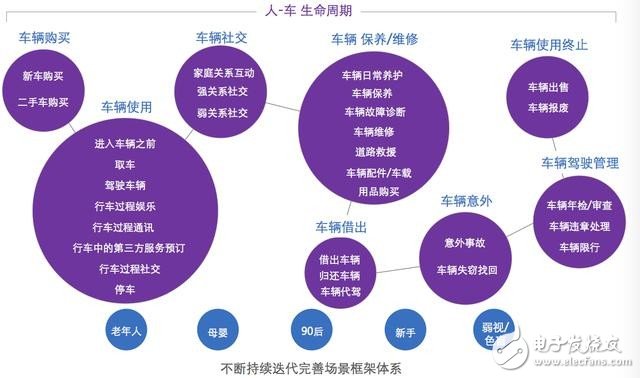What is a smart car? In a narrow sense, smart cars = car networking + new energy + automatic driving. If you use this definition to go backwards, there is currently no smart car on the market. In fact, smart cars have an advanced process, which is roughly as follows:
Internet of Vehicles + Traditional Cars = Internet Cars
Internet of Vehicles + New Energy = New Energy Vehicles
Internet of Vehicles + Automated Driving Technology = Auto Driving
Internet of Vehicles + New Energy + Auto Driving = Smart Car / Intelligent Transportation
At present, how is the development of China's car networking, from the perspective of intelligent interaction, how to shake the blue ocean of the Internet of Vehicles. There are three genres shared here.
Genre 1: Experience consulting solutions, such as Faceui
Faceui is a domestic experience consulting firm that specializes in product strategies and experience innovations tailored to different industry characteristics to create sustainable and sustainable product solutions. At present, the Internet of Vehicles has become the mainstream of their business. To this end, they have established an innovative interactive platform for facecar car networking experience, focusing on the service experience research of car networking products. Through the insight and analysis of the Internet of Vehicle users, combined with market trends and information technology, help companies explore new business opportunities in the Internet.
Facecar's research and design model for car networking products is:
First, study user behavior
Second, research user needs
Third, design the features, services, and interactions of the product.
Fourth, implement the product
Facecar founder Zhu Jiaming said that this is quite different from the process of re-developing features and products from existing technologies.
At present, facecar is developing and establishing a “cross-platform car network user behavior libraryâ€, which will conduct long-term systematic research on the behavior of fast platform car networking users and continue to improve. What can this behavior library do? First of all, for the cross-platform car networking products of different types and different needs, the corresponding scenario tasks, ie user requirements, can be found from the user behavior library to ensure whether the product function planning and design truly meet the user usage scenarios and requirements. Second, explore more potential user needs and product opportunities from the user behavior library. Third, based on different types of user task characteristics, the interaction design principles are sorted out to ensure a good user experience of the design.
So, how to build a "cross-platform car network user behavior library"? Zhu Jiaming introduced:
First, build a user behavior library framework
Second, typical user scene enumeration
Third, refine user needs and scenario tasks through user research
Fourth, task feature classification
Fifth, based on the interaction principle of different task characteristics

Separately, building a user behavior library framework system is based on the “human-car interaction life cycle†as the main latitude. Colleagues consider different user groups to build a main framework system of behavioral libraries. It is worth noting that the user behavior library is a dynamic database that will be iteratively adjusted and improved based on changes in the user's lifestyle.
The enumeration of typical user scenarios is based on a behavioral library framework that enumerates existing and potential typical user scenarios based on user usage and interaction possibilities. Scene enumeration is completely independent of user behavior and is not limited by the way existing products and services are used, as well as technical feasibility. Based on changes in the user's lifestyle, scene enumeration will also be constantly adjusted and improved.
The user's research completes the verification of the user's scene, and the user's needs and tasks are refined. Based on preliminary user research, the typical scenarios of enumerations are verified, corrected, and refined. Through more in-depth user research, combing user needs and refining specific tasks in the scene. Here, Facecar will use the “sports-on-the-scenes observation†and “one-to-one user deep interviewâ€, that is, the user researcher follows the user in the car, and analyzes the user by tracking, observing, and recording the user’s driving trajectory and usage scenarios. The actual vehicle usage and behavior. Take the “parking†section as an example. There are three typical scenarios, “Looking for parking lotsâ€, “Looking for parking spaces and parking†and “Leaving after parkingâ€.
The classification of task characteristics indicates that each scene contains a series of specific struggles, based on the refinement and induction of different task characteristics, looking for commonalities and differences, and classifying tasks from them. For example, active tasks, passive tasks, in-drive tasks, suspended tasks, and so on.
Finally, based on the interaction principle of different task characteristics, different task feature classifications have different requirements for user interaction behavior, including: interactive channels that users need, attention provided by users, information types and methods of user requirements, etc. . Based on these task classifications, the corresponding interaction design principles are proposed. For example, in driving tasks, the principle of interaction is the “minimum participation principleâ€; in the cognitive delay task, the interaction principle is “predictable principleâ€; in the cross-terminal task, the interaction principle is “seamless convergence principleâ€.
Electronic Cigarette,Largest E-Cig Oem,China E-Cig Oem,Vape Pen Oem,Vape Device Oem
Shenzhen MASON VAP Technology Co., Ltd. , https://www.e-cigarettefactory.com